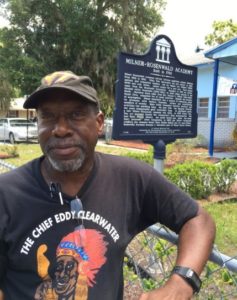Editor’s note: This February marks the 43rd anniversary of Black History Month. redefinED is taking the opportunity to revisit some pieces from our archives appropriate for this annual celebration. The article below originally appeared in redefinED in July 2016.
This is the latest post in our series on the center-left roots of school choice.

Former student Ozell Ward stands in front of a historical marker of the Milner-Rosenwald Academy in Mount Dora, Fla.
The school was all black. The textbooks, hand-me-down. The teachers paid less. Yes, the Milner-Rosenwald Academy in Mount Dora, Fla., was separate and unequal, said Ozell Ward, who attended 60 years ago.
And yet, in his view, it was better.
Teachers were invested, he said. Parents were engaged.
The community made it their “anchor.”
“Education-wise, I think I had one of the best foundations, period, despite the so-called handicaps,” said Ward, 69, a retired human resources consultant.
It may seem odd to highlight a segregated, Deep South school for a series about the roots of school choice. But the K-8 Milner-Rosenwald Academy was built during an all-but-forgotten campaign, nearly a century ago, to expand educational opportunity throughout the South. Like today’s school choice movement, it was propelled by a desire to give more and better to the kids who need it the most. The school and literally thousands like it reflected many of the core characteristics that have long defined the struggle for educational freedom, particularly in the African American experience.
It offered options (in this case, of having one formal, quality school or none at all). Private sector support. Close ties to churches and faith leaders.
And local control.
“The school was the center of the community,” said Vivian Owens, a former chemist and retired public school science teacher who also attended Milner-Rosenwald. “And the community supported it in every way.”
Irony abounds. Mount Dora, population 12,000, is a charmer of a town in the middle of Lake County, an easy-on-the-eyes stretch of Central Florida known for citrus-covered hills, stunning lake vistas – and notorious, racist violence. For nearly 30 years, it was ruled by Sheriff Willis McCall, the overseer for the county’s white bankers and citrus barons. McCall was the dark force at the center of the Groveland Four case, which generated international headlines in the 1940s and ‘50s and pitted him against Thurgood Marshall, the larger-than-life NAACP lawyer who, at the same time, was leading the charge to desegregate public schools. Thanks to the 2012 Pulitzer Prize winning book, “Devil in the Grove,” a movie is being made about the case, potentially giving millions of Americans a glimpse of the home-grown terrorism that, not long ago, was as much a part of the Florida landscape as sugar-sand beaches.
This was Florida at its worst. Yet for many African Americans here, it was also a golden age for education. (more…)

Former student Ozell Ward stands in front of a historical marker of the Milner-Rosenwald Academy in Mount Dora, Fla.
This is the latest post in our series on the center-left roots of school choice.
The school was all black. The textbooks, hand-me-down. The teachers paid less. Yes, the Milner-Rosenwald Academy in Mount Dora, Fla., was separate and unequal, said Ozell Ward, who attended 60 years ago.
And yet, in his view, it was better.
Teachers were invested, he said. Parents were engaged.
The community made it their “anchor.”
“Education-wise, I think I had one of the best foundations, period, despite the so-called handicaps,” said Ward, 69, a retired human resources consultant.
It may seem odd to highlight a segregated, Deep South school for a series about the roots of school choice. But the K-8 Milner-Rosenwald Academy was built during an all-but-forgotten campaign, nearly a century ago, to expand educational opportunity throughout the South. Like today’s school choice movement, it was propelled by a desire to give more and better to the kids who need it the most. The school and literally thousands like it reflected many of the core characteristics that have long defined the struggle for educational freedom, particularly in the African American experience.
It offered options (in this case, of having one formal, quality school or none at all). Private sector support. Close ties to churches and faith leaders.
And local control.
“The school was the center of the community,” said Vivian Owens, a former chemist and retired public school science teacher who also attended Milner-Rosenwald. “And the community supported it in every way.”
Irony abounds. Mount Dora, population 12,000, is a charmer of a town in the middle of Lake County, an easy-on-the-eyes stretch of Central Florida known for citrus-covered hills, stunning lake vistas – and notorious, racist violence. For nearly 30 years, it was ruled by Sheriff Willis McCall, the overseer for the county’s white bankers and citrus barons. McCall was the dark force at the center of the Groveland Four case, which generated international headlines in the 1940s and ‘50s and pitted him against Thurgood Marshall, the larger-than-life NAACP lawyer who, at the same time, was leading the charge to desegregate public schools. Thanks to the 2012 Pulitzer Prize winning book, “Devil in the Grove,” a movie is being made about the case, potentially giving millions of Americans a glimpse of the home-grown terrorism that, not long ago, was as much a part of the Florida landscape as sugar-sand beaches.
This was Florida at its worst. Yet for many African Americans here, it was also a golden age for education. (more…)